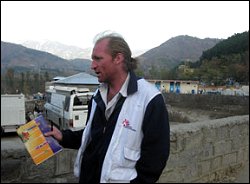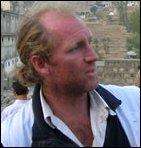Nick Lawson served as head of mission for Doctors Without Borders/Médecins Sans Frontières (MSF) in Pakistan until December 10. He arrived two days after the devastating October 8 earthquake and supervised the set-up of MSF's medical and relief aid programs in the Northwest Frontier Province, which borders Kashmir. With winter arriving, he offered an update on the situation people face and their need for continued assistance.
Nearly three months after the earthquake in Pakistan, what does the arrival of winter mean for people in the devastated regions?
Immediately after the earthquake, the major concern was that tens of thousands of people would lack shelter as winter arrived in this mountainous region. That concern was heightened by the logistical difficulties resulting from the destruction of roads. Their reopening has made it possible to deliver large quantities of material aid (tents, blankets, etc.). In addition, many families have come down from the mountain villages. In the Batagram and Mansehra districts, around 100,000 people settled in hundreds of camps spread out throughout the area.
The needs — in terms of health infrastructure, access to drinking water, quality of shelter, and other issues — vary tremendously from one camp to the next, but all the families must prepare to face the cold. We identified those families that received poor-quality tents and exchanged them for ones suited to the climate. We also distributed additional blankets and other basic supplies, based on needs. Given the risks of fire — in late November, several people died in Mansehra when a candle set fire to two tents — the best heating solution we have found so far is a kerosene system. Our teams began distributing them mid-December.
For now, we have not observed a significant increase in the number of cold-related illnesses or deaths. The significant mobilization nationally and internationally has made it possible to distribute tents, blankets and a variety of aid items widely. But the precarious living conditions in the displaced persons' camps — people living in close quarters, limited health infrastructure, difficult climactic conditions — mean that all the organizations on site must be vigilant. If winter results in high mortality among earthquake victims, that would represent a failure for everyone providing aid in the region.
Are there still many people in the mountains? How will they survive?

MSF head of mission Nick Lawson in Battagram, Pakistan Photo © MSF |
Traditionally, more than 80 percent of people in the mountain villages come down to milder areas during the winter. This year, people will probably descend to even lower elevations than normal.
When families decide to stay in the mountains, it's because they know how to make it through this difficult period. When we first began working there, two MSF teams were stationed in the Allaï and Kaghan valleys, where they distributed tents and blankets and organized medical visits. Although they covered fairly extensive areas, certain isolated villages may not have received enough supplies. Unfortunately, we are unable to go to all these villages to distribute heating systems. It's even more difficult because regular return trips are required to re-supply the kerosene.
Nonetheless, if the usual strategies for dealing with the winter have been disrupted or if living conditions become too difficult for the families who have lost homes, they can still come down into the valleys. The Pakistani government has announced that it will keep the roads open throughout the winter so that those who want to move can do so.
MSF opened a hospital facility in Mansehra that provides orthopedic care for people injured during the earthquake. What is their situation today? What are the medical problems in the region?
The facility we set up operates from inflatable tents, alongside of and in addition to the Mansehra district hospital. It is central to our work. Although it's been two months since the earthquake, hundreds of wounded people still need treatment. Because the region's health facilities, like the Battagram hospital, were badly damaged in the earthquake and need time to be repaired, our hospital is the only one that can provide orthopedic care for the wounded. It has become the district's referral center for these patients.
Many of the wounded who evacuated initially to Islamabad or Peshawar are returning to their home areas to find their family or collect the financial compensation distributed by the Pakistani government, but many of them still require daily medical monitoring or even additional surgery. In the district's displaced persons' camps, we identified 111 patients who had to be transferred to our hospital.
In addition, with an emergency room, an intensive care room and 120 hospital beds, our inflatable tent facility allows us to treat patients who cannot be admitted into the district hospital, which was severely disrupted by the earthquake.
The precarious living conditions in the displaced persons' camps — people living in close quarters, limited health infrastructure, difficult climactic conditions — mean that all the organizations on site must be vigilant
Nick Lawson




